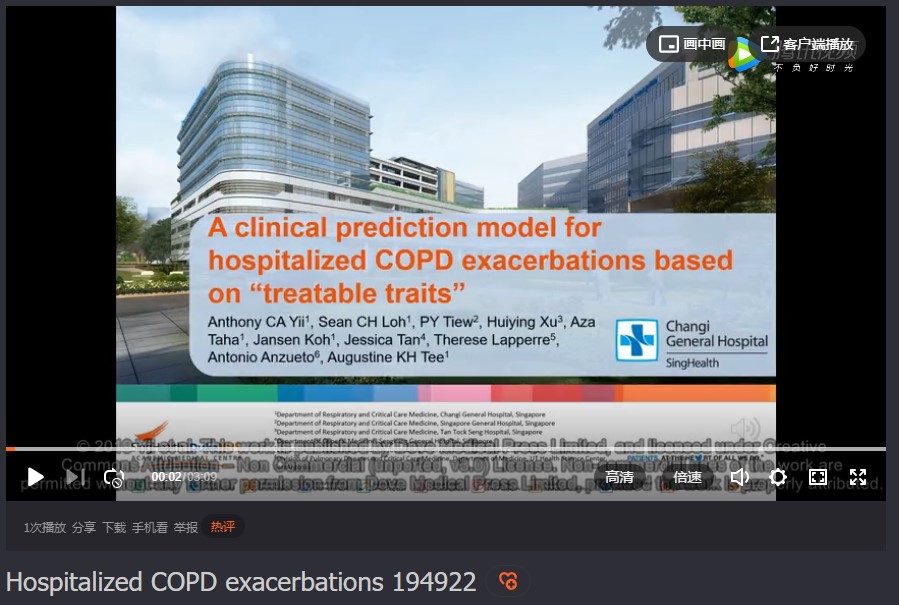9 0 5 7 8
论文已发表
注册即可获取德孚的最新动态
IF 收录期刊
- 2.6 Breast Cancer (Dove Med Press)
- 3.9 Clin Epidemiol
- 3.3 Cancer Manag Res
- 3.9 Infect Drug Resist
- 3.6 Clin Interv Aging
- 4.8 Drug Des Dev Ther
- 2.8 Int J Chronic Obstr
- 8.0 Int J Nanomed
- 2.3 Int J Women's Health
- 3.2 Neuropsych Dis Treat
- 4.0 OncoTargets Ther
- 2.2 Patient Prefer Adher
- 2.8 Ther Clin Risk Manag
- 2.7 J Pain Res
- 3.3 Diabet Metab Synd Ob
- 4.3 Psychol Res Behav Ma
- 3.4 Nat Sci Sleep
- 1.9 Pharmgenomics Pers Med
- 3.5 Risk Manag Healthc Policy
- 4.5 J Inflamm Res
- 2.3 Int J Gen Med
- 4.1 J Hepatocell Carcinoma
- 3.2 J Asthma Allergy
- 2.3 Clin Cosmet Investig Dermatol
- 3.3 J Multidiscip Healthc

A clinical prediction model for hospitalized COPD exacerbations based on “treatable traits”
Authors Yii ACA, Loh CH, Tiew PY, Xu H, Taha AAM, Koh J, Tan J, Lapperre TS, Anzueto A, Tee AKH
Received 16 November 2018
Accepted for publication 1 February 2019
Published 27 March 2019 Volume 2019:14 Pages 719—728
DOI https://doi.org/10.2147/COPD.S194922
Checked for plagiarism Yes
Review by Single-blind
Peer reviewers approved by Dr Colin Mak
Peer reviewer comments 3
Editor who approved publication: Dr Richard Russell
Background: Assessing risk of future exacerbations is
an important component in COPD management. History of exacerbation is a strong
and independent predictor of future exacerbations, and the criterion of ≥2
nonhospitalized or ≥1 hospitalized exacerbation is often used to identify
high-risk patients in whom therapy should be intensified. However, other
factors or “treatable traits” also contribute to risk of exacerbation.
Objective: The
objective of the study was to develop and externally validate a novel clinical
prediction model for risk of hospitalized COPD exacerbations based on both
exacerbation history and treatable traits.
Patients and methods: A total of 237 patients from the COPD Registry of Changi General
Hospital, Singapore, aged 75±9 years and with mean post-bronchodilator FEV1 60%±20% predicted, formed the derivation
cohort. Hospitalized exacerbation rate was modeled using zero-inflated negative
binomial regression. Calibration was assessed by graphically comparing the
agreement between predicted and observed annual hospitalized exacerbation
rates. Predictive (discriminative) accuracy of the model for identifying
high-risk patients (defined as experiencing ≥1 hospitalized exacerbations) was
assessed with area under the curve (AUC) and receiver operating characteristics
analyses, and compared to other existing risk indices. We externally validated
the prediction model using a multicenter dataset comprising 419 COPD patients.
Results: The
final model included hospitalized exacerbation rate in the previous year,
history of acute invasive/noninvasive ventilation, coronary artery disease,
bronchiectasis, and sputum nontuberculous mycobacteria isolation. There was
excellent agreement between predicted and observed annual hospitalized
exacerbation rates. AUC was 0.789 indicating good discriminative accuracy, and
was significantly higher than the AUC of the Global Initiative for Chronic
Obstructive Lung Disease (GOLD) risk assessment criterion (history of ≥1
hospitalized exacerbation in the previous year) and the age, dyspnea, and
obstruction index. When applied to the independent multicenter validation
cohort, the model was well-calibrated and discrimination was good.
Conclusion: We
have derived and externally validated a novel risk prediction model for COPD
hospitalizations which outperforms several other risk indices. Our model
incorporates several treatable traits which can be targeted for intervention to
reduce risk of future hospitalized exacerbations.
Keywords: exacerbations,
clinical prediction model, risk assessment
摘要视频链接:Hospitalized COPD
exacerbations
